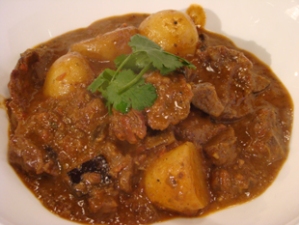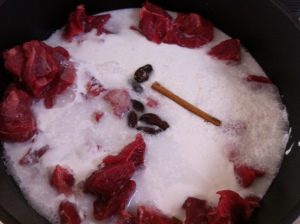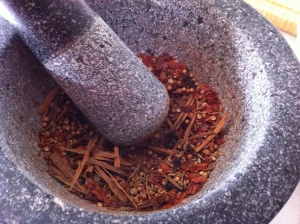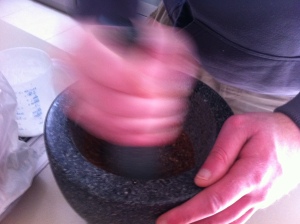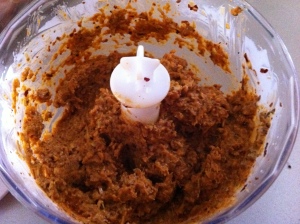Blog Archives
Beef Masaman Curry – rich and delicious
Watching Rick Stein on his Eastern Odyssey around Asia, I couldn’t help but be inspired to recreate this amazing Thai dish.
It’s aromatic, nutty, warm with chilli, but far from blowing your head off, and it fills your home with the beautiful spicy fragrances of cinnamon, cloves and cardamom.
I was intimidated by the ingredient list – but one stop to my local Indian grocer and I was set. The lady at the shop was amazing – she whizzed around the little store with me looking at my list and grabbing everything I needed, including blade mase – which I had NEVER seen before. I strongly suggest you do the same – hit your local Indian/Asian grocer and the shopping list will no longer be a hassle!
I have to admit, I was also stressing about the chilli content – I mean 12 dried chillies sounded way over the top for a curry considered to be very mild in terms of Thai food. But, as you will see, this recipe calls for Kashmiri chillies – which I have since found out are hardly spicy at all. I’m glad I didn’t chicken out and reduce the amount of chilli, because at the end, it was just perfect.
This dish is definitely a weekend project – when you have time on your hands and just feel like having some “me” time in the kitchen with your mortar and pestle. It took hours to create this – but when we sat down and took the first bite – it was instantly worth it! Better than any jarred massaman curry I have ever tasted.
I have taken most of this recipe straight from Rick – but have added a few changes which I found worked well along the way.
Curry paste
- 10 dried red kashmiri chillies, seeds removed, roughly chopped
- 2 tbsp coriander seeds
- 1 tbsp cumin seeds
- 1 tsp green cardamom seeds (from about 20 green cardamom pods)
- 16 cloves
- 1 cinnamon stick
- 2 large pieces of blade mace
- 3 tbsp vegetable oil
- 1 small onions, roughly chopped
- 4 garlic cloves, peeled, roughly chopped
- 1 tsp shrimp paste
- 2cm piece of fresh ginger, peeled and roughly chopped
- 2 lemongrass stalks, tough outer leaves removed, soft inner core chopped
- 1/4 cup of coconut cream
The curry
- 1.5kg of chuck steak, cut into large chunks
- 600ml of coconut cream
- 6 black cardamom pods
- 1 cinnamon stick
- 1 tsp salt
- 3 large potatoes, peeled and chopped into large cubes
- 8 shallots, finely diced
- 2 tbsp fish sauce
- 1 tsp of tamarind paste
- 1 tbsp palm sugar
- 1/2 a cup of peanuts, roasted and roughly chopped
Method
For the curry, place the beef into a heavy-based pan with 350ml of the coconut milk and an equal amount of water. Add the black cardamom pods, cinnamon stick and salt, then bring to a simmer and partially cover the pan with a lid, leaving just a small gap for the steam to escape. Cook for two hours, stirring occasionally, until the beef is just tender. While that’s simmering, you can tackle the curry paste.
Heat a dry, heavy-based frying pan over a medium heat. Add the dried chillies and fry for 1-2 minutes, shaking the pan frequently to prevent the chillies from burning, until the chillies are lightly toasted. Transfer the chillies to a spice grinder or mortar.
Return the pan to the heat and add the coriander, cumin and cardamom seeds, cloves, cinnamon and blade mace and fry for a few seconds, shaking the pan frequently, until the spices darken slightly and release their aromatics. Add the toasted spices to the spice grinder or mortar and grind or pound to a fine powder.
Heat the oil in a frying pan, add the onion and garlic and fry slowly over a medium heat, stirring occasionally, for 20 minutes or until caramelised. Add the shrimp paste and spice mixture and fry for a further 2-3 minutes.
Transfer the mixture into a food processor, add all of the remaining curry paste ingredients and blend to a smooth paste. Set aside until your beef has cooked for the two hours set out above.
Meanwhile, peel the potatoes and cut into large pieces.
Now that the curry has been simmering for two hours, remove the lid from the curry and discard the black cardamom pods and cinnamon stick. Stir in the rest of the coconut milk, the potatoes, shallots, the curry paste, fish sauce, tamarind and sugar and simmer gently, uncovered, for a further 25-30 minutes, or until the potatoes, shallots and beef are tender. Stir in the peanuts.
Serve with steamed rice and some fresh, chopped red chillies for those who like their curries a little hotter.
As for my music recommendation – due to the long process – I suggest your going to need an album … or three!
However, if you can get your hands on Adele’s new album called 21 – and if you appreciate a truly amazing voice and chilled melodies – you can simply play it over and over and … over again 🙂
In an act of support for how awesome this chick is, I’m linking to two of her songs – firstly Rolling Deep – which I admit is becoming a tad over-played.
But, here’s another awesome song from the album, Someone Like You. In this video, she also talks about her inspiration for writing this amazing song.
Happy cooking, eating and grooving!
The Weekly Cook Up: Marinades
Marinating meat is a great way to not only save time, but to inject lots of awesome flavour into a week-night meal.
This week I’m going to share with you three really awesome marinades, which can be used on chicken, beef and lamb which will have your family raving not only about the great flavours, but also the tenderness of the meat.
Marinading meat is so convenient because you can do your weekly/fortnightly or monthly shop and marinate whatever meats you wish before popping them in the freezer. Once thawed, all that is left to do is cook it, and because it will be bursting with flavour, a simple salad or side of vegies is the only accompaniement required.
Don’t know much about marinating? Well, you’ll see from the below recipes that there are generally three main ingredients in each – acid (like lemon juice), oils and seasonings (herbs, spices, salt and pepper etc). The oils and the acids help tenderise the meat and break down the fibres to allow the seasonings to penetrate their great flavour. Once you get hold of a few good marinating recipes and start to understand what flavours work – then you’ll be making up your own before you know it!
Greek-style marinade
- Half a cup of olive oil
- The juice of a whole lemon
- 1 tsp of ground black pepper
- 1/2 a tsp of sea salt
- 2 garlic cloves, peeled and finely chopped
- 1 tbs of dried oregano
This marinade is great for chicken thighs or lamb chops, which can then be grilled on a hot pan or on the barbecue.
You could also spread it over a whole chicken or on maryland pieces (which is the cut with the thigh and leg bone, joined together) before roasting in a medium oven (about 180 to 200 degrees C – cooking times depend on the size of your whole bird, but marylands should take about 45 minutes).
But this is most ideal on a leg of lamb before roasting, or ask you butcher to butterfly the leg – which means he’ll remove the bone, leaving a nice flat piece of meat. Marinate it, and then cook it on the barbecue. It’s just amazing!
Spicy Asian Marinade
-
2cm piece of ginger, finely chopped
-
1 clove of garlic, finely chopped
-
1/2 a red chilli, finely chopped (remove seeds to reduce spice)
- 1/2 a green chilli, finely chopped (remove seeds to reduce spice)
- 5 tbs of soy sauce
- 2 tbs of fish sauce
- 1/4 of a cup of peanut oil
- 1 tsp of sugar
- The juice of half a lime
This marinade is ideal for chicken and beef. Chicken strips can be marinated and stir-fryed with some Asian greens, or beef steaks will soak up these beautiful flavours before being cooked medium to rare on a barbecue and used in a Asian beef salad. It’s also great for meats you want to skewer and then barbecue. Beware though, it is quite spicy – so not one for the kids.
Moroccan marinade
-
1/2 a cup of olive oil
-
1/4 cup of red wine vinegar
-
2 tbs of Moroccan spice blend/seasoning
-
1 tsp of lemon zest
-
1/2 a tsp of sea salt
-
1/2 a tsp of black pepper
This marinade is very versatile and is great for all cuts of chicken, is fabulous on lamb chops or back strap (cooked medium on the barbecue) or on tender cuts of beef.
Method and tips for all marinades
Combine all ingredients and whisk well. All these marinades yield enough for 1 to 1.5 kilograms of meat. The best way to marinade it to place meat in a freezer bag, add marinade and seal the bag, ensuring all the air is out. Toss, turn and massage the meat in the bag (having the bag sealed prior to doing this exercise saves your hands from getting all dirty, but ensures the meat and marinade is well combined). Ensure you use a large enough freezer bag for your quantity of meat.
Freeze for up to three months. To thaw – place the frozen meat in the fridge the night before you need it. This is the most hygienic way of thawing meat.
You can marinate the meat on the same day as you plan to use it, but the flavour won’t be as good. However, as long as the meat has at least 2 hours in the fridge, it will still be delicious.
This really is the simplest and easiest process to inject wonderful flavour. So, no more boring lamb chops or roast chickens. Inject some flavour – your family will thank you!
Any questions about marinating? Feel free to post them in the comments section below.
And before I forget – Uforic Food now has its very own Facebook page. Visit it here and don’t forget to ‘like’ us!
Be Inspired~
Lisa
And while we wait … the best fried rice ever
It’s been a few days between recipes, and so I thought I’d share with you one that was inspired by the amazing Kylie Kwong. I watched her make this fried rice on her cooking show and it made me sooo hungry!!! I also loved it because it was so simple – she doesn’t add everything under the sun like sweet corn and peas (eewww so bad in fried rice!!) and little pieces of capsicum and carrots. Now Kylie’s didn’t have bacon in it – but I love it in fried rice – so I added it. I changed a few other bits and pieces as well.
I used to battle with making this dish because the rice would always go gluggy. Here are a few tips:
- Cook your rice the night before. Fluff it with a fork and refrigerate
- I find jasmine rice is too starchy – so I use basmati (I know, not authentic, but it works and it’s better for you!)
- When you take the rice out of the fridge, don’t just bung it in the wok – separate it with a fork, or use your fingers.
- Make sure your wok is hot and don’t keep the rice in there long – it really only needs to fry slightly and reheat.
The very best fried rice
Method
Cook your rice (I use basmati, as mentioned above), fluff it with a fork and leave it to cool completely in the fridge.
Place the oil in a hot wok and fry off the bacon, until it is just about to go crisp. Add red onions and let them soften.
Meanwhile, place the eggs in a bowl with spring onions, half the soy sauce and ginger and lightly beat with a fork to combine.
Pour in the egg mixture and leave to cook for 10 seconds before folding eggs over onto itself with a spatula and lightly scrambling for about 1 minute or until almost cooked through. Please don’t fully cook the eggs at this point, otherwise they will be tough later.
Add rice and extra soy sauce and stir-fry for about 1 1/2 minutes, using a spatula to break up the egg into smaller pieces. It really nicely starts to coat the rice and it tastes amazing! Make sure you taste it as this point and see if it needs any more soy. I like quite a bit in this so I do get a bit heavy-handed!
I served this with some marinated chicken. I just used some soy, sweet chilli sauce and a touch of rice wine vinegar and fresh, finely sliced red chilli, coated it and fried it in the wok.
Such a quick, easy weekday meal which you will love.
Be Inspired~
Lisa
Got a fridge full of Christmas leftovers? Here are some solutions!
Leftovers are one of the best and worst parts of Christmas.
Tonight we enjoyed a lovely spread of cold pork, ham and turkey – and with a nice warm potato salad and green salad – it was a very yummy, quick and easy dinner.
But we all know there is only so many times a person can enjoy cold meats and salad for lunch and dinner – so here are some really great, quick meals to utilise you leftover ham, pork and turkey. Best of all, they are all rather light, which is what we all want following the eating fest that is Christmas Day – and they really transform the leftovers – adding kick, punch and interest, rather than feeling like you have to eat roast over and over. Although – I LOVE a good roast and I have to say Matt’s mum puts on an amazing spread for Christmas – I felt very lucky to be a part of the day!
Give these a go … I promise after slaving in the kitchen the past few days – these meals will be a breeze! First up, there’s nothing like a good salsa to liven things up …
Sliced Leg Ham with Mango, Avocado and Chilli salsa
1 large ripe mango, peeled, cut into 2cm pieces
1 large avocado, halved, stone removed, peeled, cut into 2cm pieces
1 fresh red birdseye chilli, halved lengthways, deseeded and finely chopped
1/2 cup fresh coriander leaves
2 tbs finely chopped red onion
2 tbs fresh lime juice
1 tbs extra virgin olive oil
Salt and freshly ground black pepper
5kg (about 1/2) leg of ham, thinly sliced
Method:
Place the mango, avocado, chilli, coriander, onion, lime juice and oil in a medium glass or ceramic bowl. Gently toss until well combined. Taste and season with salt and pepper. Transfer to a serving bowl or glass.
Arrange the ham on a serving platter and serve immediately with the salsa.
Thai-inspired Turkey Salad
2 tbsp fresh lime juice
55 ml of soy sauce
1 tbsp ginger, grated
1 tsp ground star anise
2 tbsp fish sauce
2 tsp honey
450 g cooked turkey meat, cut into half inch strips
2 red chillies, seeded and finely chopped
4 spring onions, sliced
1 cucumber, peeled, seeded and sliced
3 tomatoes, cut into wedges
2 tbsp coriander leaves
2 tbsp basil
black pepper
mixed salad leaves, to serve
Method:
In a saucepan combine the lime juice, soy, ginger, star anise, fish sauce and honey.
Cook for 2 minutes over a medium heat, allow to cool.
Add the remaining ingredients, except the salad leaves. Season to taste and serve on the dressed salad leaves.
Asian Pork Rice Paper Rolls
150g dried rice vermicelli noodles
16 small round rice paper wrappers (you can get these in the Asian isle at the supermarket)
1 cos lettuce, leaves separated, washed, dried
2 Lebanese cucumbers, halved, cut into thin strips
1/2 cup Thai basil leaves
250g (2 cups) roasted pork, cut into strips
1/3 cup sweet chilli sauce
The juice if 1 lime
Soak noodles following packet directions. Drain. Refresh in cold water and drain.
Half-fill a shallow dish with warm water. Dip 1 rice paper wrapper into water. Place on work surface. Place lettuce at edge of rice paper. Top with noodles, cucumber, basil and pork. Roll up, folding edges in to enclose filling. Cover rice paper rolls with a damp tea towel to prevent drying out. Repeat with remaining rice paper wrappers, noodles, lettuce, cucumber, mint, basil and pork to make 16 rolls.
Combine sweet chilli and 1 1/2 tablespoons lime juice in a screw-top jar. Secure lid and shake until well combined. Serve rice paper rolls with sweet chilli dipping sauce.
There you have three delicious recipes which are quick, tasty, light and will ensure all your leftovers get used without you having to feel like you are eating the same thing over and over again.
I’d like to take this opportunity to thank everyone who has supported me in my writing this year. I have enjoyed sharing my recipes with you. I hope you’ll keep reading in 2011 as I start the year exploring all different cuisines from across the globe! It promises to be a fabulous culinary journey. But until then …
Be Inspired~
Lisa
Day 16 – Steamed baby snapper with Asian flavours
I love cooking snapper whole – there’s something about putting a whole fish in the middle of the table that makes you feel like you are about to embark on a feast.
I use baby snapper because I love the pink skin and its size means it’s not too hard to fit it in the steamer. It cooks quickly and the flesh tastes sweet and is really good at taking on other flavours.
This recipe is from Aussie chef Neil Perry. I have eaten at his restaurant, Rockpool Bar and Grill twice now – and we’re about to go back a third time in December for mine and Matt’s anniversary. We made the booking about two months ago and both cannot wait!! At Rockpool the menu is all about the best beef you’ll ever eat. However, I have watched many of Neil’s shows and he certainly has a way with fish and seafood.
So I really hope you give this recipe a go. It’s been a while since I last made it, but as summer draws nearer – this will certainly be on my menu more regularly.
Whole baby snapper with Asian flavours
- 1 kg snapper scaled and cleaned (your fish monger should be able to do this, and they are already to go in the deli cabinet at the supermarket)
- 1 Chinese cabbage leaf
- 3 shallots left whole
- ½ tsp of sea salt
- 2 tbs of light soy sauce
- 1 tbs sesame oil
- 2 tbs shao xing cooking wine
- 1 tbs caster sugar
- 1 large knob of Ginger finely julienned
- 4 shallots finely chopped
- 3 tbs of peanut oil
- 1/4 cup of chopped, fresh coriander
Method
With the whole fish on your chopping board, take a sharp knife and make three diagonal slits into the meatiest part of the fish. Repeat this in the opposite direction to create a diamond pattern. Turn the fish and repeat the process on the other side.
Put the cabbage leaf and whole shallots on the bottom of a heatproof bowl that will fit into the steamer and take the fish comfortably. Rub the fish with salt and put it into the bowl on top of the shallots.
Mix the soy, sesame oil, shao xing wine and castor sugar and pour over the fish, then top with the ginger.
Put the bowl in the steamer (I use a bamboo steamer, which you can buy really cheaply at an Asian grocer) over rapidly boiling water and steam for 10-15 minutes. Keep an eye on it though, to ensure it doesn’t over cook.
Remove the bowl from the steamer and scatter the shredded shallots over the fish.
Now for the fun, but dangerous part!! Heat the peanut oil in a small pan until it is smoking, then douse the fish with the oil – be careful, it will spit! (The fish can be served straight from the steamer bowl but if you wish to transfer it to a platter, you should do so before you pour it over the hot oil.)
Top with the fresh coriander and serve straight away.
This dish is full of amazing flavours. I hope you give it a go.
Be Inspired~
Lisa
